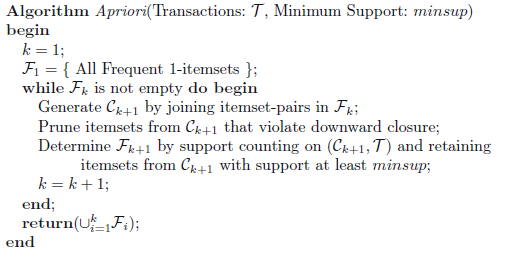Association rule mining is the basis for pattern recognition within multiple applications to find frequent relations, causal structures or correlations between occurrences of data. Common applications of association rule mining are market basket analysis, fraud detection, medical diagnosis, cross-marketing etc. Association guides decision making based on the historical data that exists.
An association rule is represented in the format:
- Antecedent -> Consequent,
which are defined by the measures of interestingness i.e support and confidence following a given threshold. These established rules can be be categorised as: actionable rules- having relevant insights, trivial rules- known to people with domain knowledge and inexplicable- relationships have no explainable insight and impact. There a couple of measures used with regard to the association rules.
The measures of interestingness
Support is the frequency of the rule within the data. It is given by:
- support(A -> B) = p(A and B)
Confidence is the percentage of occurrences containing A which also contain B. Given by:
- confidence(A -> B) = p(B|A) = sup(A,B)/sup(A)
Apriori algorithm
This algorithm relates to associative rule mining from frequent occurrence sets by relying on the downward closure property.
“The Apriori algorithm generates candidates with smaller length k first and counts their supports before generating candidates of length \((k+1)\). The resulting frequent k-itemsets are used to restrict the number of \((k + 1)\)-candidates with the downward closure property”
This phenomenon restricts the cost for generating frequent patterns or occurrences based on the support threshold defined.

Anti monotone property
To implement the anti monotone property while generating the association rules; the following theorem is held on the confidence measure;
“Let \(Y\) be an itemset and \(X\) is a subset of \(Y\) . If a rule \(X \rightarrow Y - X\) does not satisfy the confidence threshold, then any rule \(\tilde{X} \rightarrow Y -\tilde{X}\),where \(\tilde{X}\) is a subset of \(X\), must not satisfy the confidence threshold as well.”
This theorem can be proved by comparing the confidence of the rules \(X \rightarrow Y - X\) and \(\tilde{X} \rightarrow Y -\tilde{X}\). The confidence of the rules are sup(\(Y\))/sup(\(X\)) and sup(\(Y\))/sup(\(\tilde{X}\)). \(\tilde{X}\) being a subset of \(X\), then sup(\(\tilde{X}\)) \(\geq\) sup(\(X\)), therefore the rule \(\tilde{X} \rightarrow Y -\tilde{X}\) can not have a higher confidence than \(X \rightarrow Y - X\).This is applicable for a given itemset.
This implies that if a certain rule of a given itemset is discarded that it does not meet the minimum confidence threshold, then all the subsets of the antecedent of the particular rule do not need to be explored as they will definitely have a lower confidence. This increases the speed of the program as not all combinations of itemsets do not have to be explored.
Resources
- Data Mining by Charu C. Aggarwal
Code implementation in Matlab
% input parameters: minsup = minimum support, minconf = minimum confidence,
% antimonotone = true(to use the property)/ false(ignore the property)
function rules = associationRules(minsup,minconf, antimonotone)
shoppingList = readDataFile;
ntrans = size(shoppingList,1);
items = unique([shoppingList{:}]);
nitems = numel(items);
[tridx,trlbl] = grp2idx(items);
% Create the binary matrix
dataset = zeros(ntrans,nitems);
for i = 1:ntrans
dataset(i,tridx(ismember(items,shoppingList{i}))) = 1;
end
% Generate frequent items of length 1
support{1} = sum(dataset)/ntrans;
f = find(support{1} >= minsup);
frequentItems{1} = tridx(f);
support{1} = support{1}(f);
% Generate frequent item sets
k = 1;
while k < nitems && size(frequentItems{k},1) > 1
% Generate length (k+1) candidate itemsets from length k frequent itemsets
frequentItems{k+1} = [];
support{k+1} = [];
% Consider joining possible pairs of item sets
for i = 1:size(frequentItems{k},1)-1
for j = i+1:size(frequentItems{k},1)
if k == 1 || isequal(frequentItems{k}(i,1:end-1),frequentItems{k}(j,1:end-1))
candidateFrequentItem = union(frequentItems{k}(i,:),frequentItems{k}(j,:));
if all(ismember(nchoosek(candidateFrequentItem,k),frequentItems{k},'rows'))
sup = sum(all(dataset(:,candidateFrequentItem),2))/ntrans;
if sup >= minsup
frequentItems{k+1}(end+1,:) = candidateFrequentItem;
support{k+1}(end+1) = sup;
end
end
else
break;
end
end
end
k = k + 1;
end
% antimonotone implementation
rules = {}; % cell array of extracted rules
ct = 1; % count of the rule generated
for i =2:length(support)-1 % no association rules for the first itemset
Lset = frequentItems{i};
for itemset=1:size(Lset,1)
% specific frequent itemset
whichset = Lset(itemset,:);
allcombin ={}; % all subsets in this itemset
for j=1:(length(whichset)-1) % get combinations of size k-1
allsets = nchoosek(whichset,j); %subsets S of whichset of size j
for row=1:size(allsets,1)
allcombin{end+1,1} = allsets(row,:);
end
end
allcombin = flip(allcombin);
disantecedents = {}; % discarded antecedents for anitmonotone
%for every non empty subset s of x output the rule S => I-S
for f=1:length(allcombin)
if antimonotone
%anti-monotone
% If a rule S->(I ?S) does not satisfy the confidence threshold,
% then any rule S?-> (I ? S?),where S? is a subset of S,
% must not satisfy the confidence threshold as well
%check if combination is a subset of any of the discarded
occur = cellfun(@ismember,repmat(allcombin(f), size(disantecedents)), disantecedents, 'UniformOutput',false);
found = any(cellfun(@all, occur)); % true or false if any of the combinations is a subset of the
if found
%if allcombination is a subset, then skip to next iteration
continue
end
end
notsubset = setdiff(whichset, allcombin{f}); %I-S
%extracting the support values
whichsupcol = length(allcombin{f}); % cell index dependent on size of itemset
indexincol = find(ismember(frequentItems{whichsupcol}, allcombin{f},'rows'));
conf = support{i}(itemset)/support{whichsupcol}(indexincol);
if antimonotone && conf < minconf
disantecedents{end+1,1} = allcombin{f};
else if conf >= minconf
rules{ct, 1} = items(allcombin{f});
rules{ct, 2} = items(notsubset);
rules{ct, 3} = conf;
ct = ct+1;
end
end
end
end
end